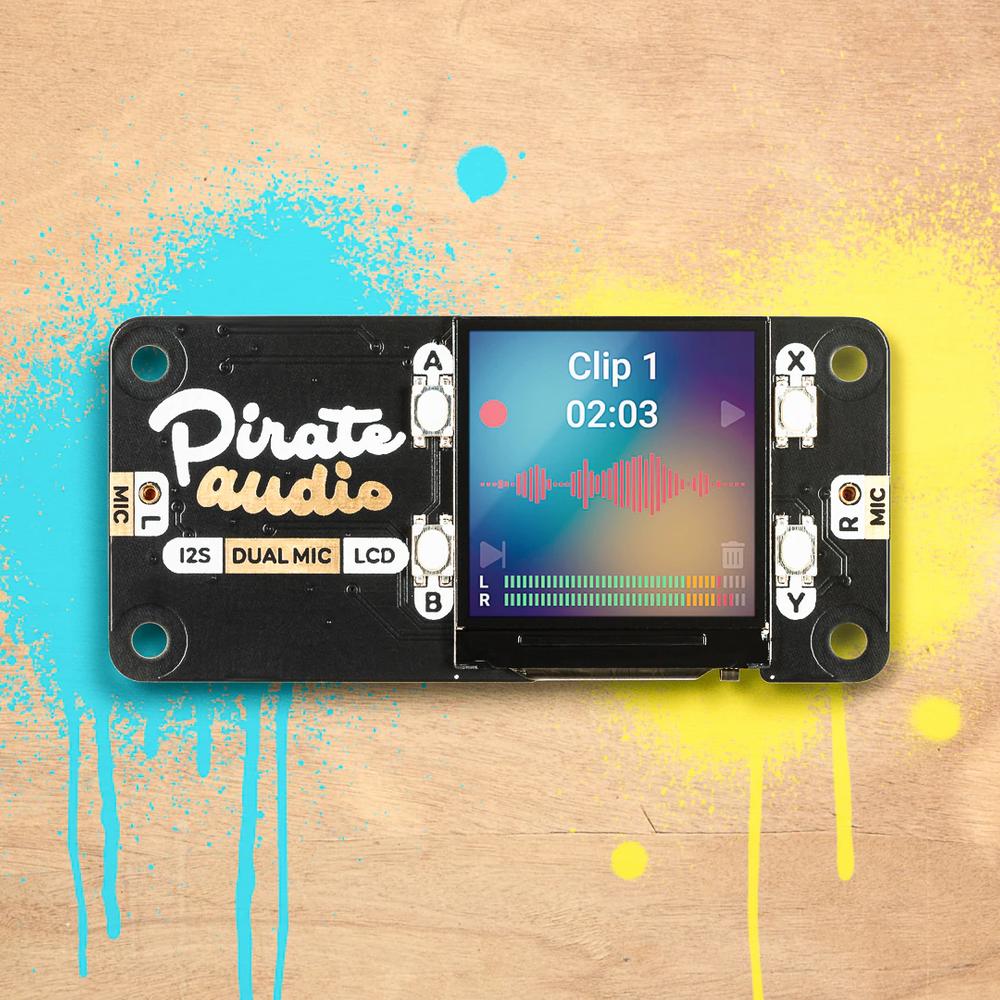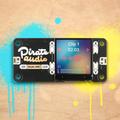Pimoroni Pirate Audio: Dual Mic for Raspberry Pi - PIM524

Description Links Attachments
Capture sounds in stereo and store them safely away in your Raspberry Pi with Pirate Audio: Dual Mic. It has a matched pair of I2S microphones, a vibrant high-res colour display, and four tactile control buttons.
This Raspberry Pi mini HAT is perfect for recording stereo audio clips at the click of a button. You could use it as a mini Dictaphone for recording important notes, shopping lists, melodies or prophetic dreams, or if you wanted to take it a step further you could use it to capture sounds to analyse with machine learning or even hook it up to Google Assistant or Alexa APIs.
Pirate Audio is a range of all-in-one audio boards for Raspberry Pi, with high-quality digital audio, beautifully-crisp IPS displays, tactile buttons for software control and custom Pirate Audio software.
Features
- 2x SPH0645LM4H-B microphones (datasheet)
- 1.3" IPS colour LCD (240x240px) (ST7789 driver)
- Four tactile buttons
- Mini HAT-format board
- Fully-assembled
- Compatible with all 40-pin header Raspberry Pi models
- Pirate Audio software
- Dimensions: 31mm x 65mm x 9mm (approx., including screen and header)
Software
We've put together a clip recorder example application to show you how to record audio files and play them back, as well as a convenient installer!
Here's how to get started:
- Set an SD card up with the latest version of Raspberry Pi OS.
- Connect to Wi-Fi or a wired network.
- Open a terminal and type the following:git clone https://github.com/pimoroni/pirate-audiocd pirate-audio/clip-recordersudo ./install.sh
- Reboot your Pi
(There's more info about what the installer does, what audio plugins we've used and how to install them manually on Github).
Notes
- The buttons are active low, and connected to pins BCM 5, 6, 16, and 24.
- Unlike the other Pirate Audio boards, Dual Mic doesn't have any chunky components on the underside so it will work fine with a Pibow Coupé case without a booster header.
- Please note that Pirate Audio: Dual Mic doesn't have any audio output itself, so if you want to be able to listen back to what you've recorded you'll need to use a full size Raspberry Pi with an audio jack, or some alternative audio arrangement, like a Bluetooth speaker or audio over HDMI.
- I2S supports both input and output devices, so if you're happy hacking on the mystical device tree overlay you could potentially use one of our other Pirate Audio boards for audio output, via something like a HAT Hacker HAT.
Properties
| Brand | Pimoroni |
| Model | PIM524 |
Alternative products
Customer questions
Customer Reviews
- Reduced In stock -56 % Pimoroni Maker Essentials - Micro-motors & Grippy Wheels € 21,80 € 9,70 View product
- In stock Pimoroni HyperPixel 4.0 - Hi-Res Display for Raspberry Pi - touch € 57,60 View product
- In stock Pimoroni Tiny 2040 - 8MB Headered - PIM592 € 12,30 View product
- In stock Pimoroni Aluminium Heatsink Case for Raspberry Pi 4 - Black € 11,20 View product
- In stock Pimoroni LiPo SHIM for Pico - PIM557 € 8,80 View product
- In stock Pimoroni Pirate Audio: Speaker for Raspberry Pi € 20,- View product
- In stock Pimoroni PMS5003 Particulate Matter Sensor with Cable € 24,- View product
- In stock Pimoroni Maker Essentials - Various Headers € 6,85 View product
- In stock Pimoroni Extended Pi Standoffs € 4,75 View product
- 2 pieces In stock Pimoroni M2.5 Standoffs for Pi HATs - Black Plated - Pack of 2 € 2,55 View product
- In stock Pimoroni Raspberry Pi 4 Heatsink € 2,90 View product
- In stock Pimoroni 1.12" OLED (128x128, white/black) Breakout € 16,80 View product
- Pimoroni Maker Essentials - LEDs & Resistors € 6,65 View product
- Pimoroni Maker Essentials - Mini Breadboards & Jumper Jerky € 10,50 View product
- Pimoroni Maker Essentials - Switches & Potentiometers € 8,50 View product










